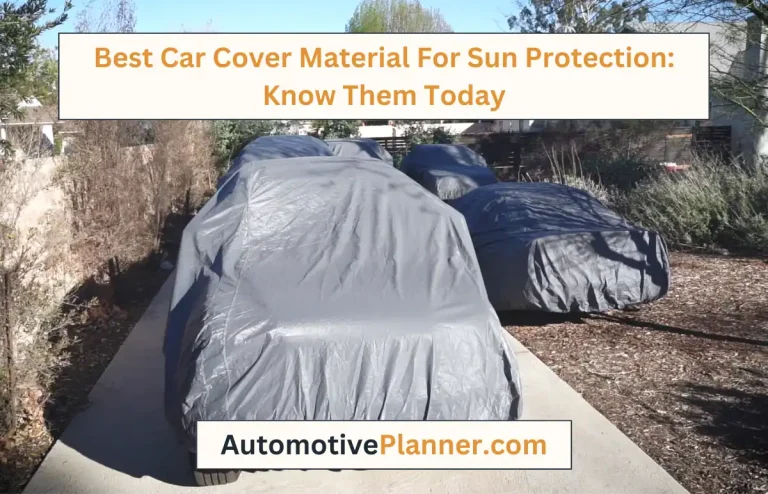How To Make A Hail-Proof Car Cover? [Easy DIY Process]
What if you could create a tailor-made, DIY solution that not only protects your vehicle but also reflects your craftsmanship? Making a hail-proof car cover is more than just a practical endeavor. It’s an opportunity to infuse your unique style into a protective layer. But how to make a hail-proof car cover like a pro?
Creating a hail-proof car cover involves precise steps. From accurate car measurements and selecting durable fabrics to sewing techniques and optional enhancements everything is crucial. Remember to include finishing touches like zippers or Velcro for added convenience.
In this guide, you’ll learn the process step-by-step, the benefits hail-proof car cover offers, and tips to get the most out of it. So stay tuned and read the whole thing.
14 Steps to Make a Hail Proof Car Cover:
Making a car cover at home can be a rewarding DIY project that helps protect your vehicle from the elements. Here’s a step-by-step guide to creating a simple car cover:
Step 1: Measure Your Car
Accurately measure your car’s length, width, and height using a measuring tape. Ensure that you add extra inches to each dimension to account for the necessary drop and to cover the sides of the vehicle adequately.
This precise measurement is crucial in creating a custom-fit cover that provides optimal protection. Taking the time to measure your car accurately will lay the foundation for a well-fitted and effective DIY car cover.
Step 2: Create A Custom Pattern
Creating a custom pattern is crucial for ensuring a perfect fit and maximum coverage. To fashion a custom pattern for the cover, lay a sizable piece of lightweight fabric over your vehicle, ensuring it’s free of wrinkles. Secure it along the edges using masking tape or pins.
With precision, trace the outline of your car onto the fabric, capturing every contour and feature. Once traced, carefully remove the fabric and cut along the lines to create your tailored pattern.
Step 3: Ensure Weather-Resistant Coatings
Ensure weather-resistant coatings to protect the car cover and vehicle from moisture and UV damage. Examples of suitable coatings include polyurethane or acrylic coatings, which provide a waterproof barrier and prevent fading due to sunlight exposure.
These coatings enhance the durability and longevity of the cover, ensuring reliable protection against hail and other weather conditions.
Step 4: Choose Stronger Materials
Select robust materials such as PVC (polyvinyl chloride) or rubber to withstand hail impact effectively. PVC offers durability and water resistance, while rubber provides flexibility and resilience against harsh weather conditions.
In addition, consider other heavy-duty fabrics like polyester or polyethylene, known for their strength and tear resistance. These materials ensure the car cover can endure the force of hailstones without sustaining damage.
Step 5: Cut The Fabric
Lay out your chosen weather-resistant fabric on a flat surface. Utilize the measurements obtained in Step 1 to cut the fabric, making sure to include additional inches (2”-4”) on each side for seam allowances.
The accurate cutting of the fabric is essential for creating a cover. This way it fits your car properly and allows for seamless sewing in the subsequent steps.
Attention to precision during this stage contributes to the overall effectiveness and aesthetic appeal of the DIY car cover.
Step 6: Sewing The Fabric Into Multiple Layers
After cutting the fabric pieces, assemble them according to your design. Layer the pieces as necessary, ensuring alignment and symmetry. Secure the layers together with pins to prevent shifting during sewing.
Use a heavy-duty sewing machine with a strong needle to stitch the layers together, maintaining even tension and straight lines. Repeat the process for each additional layer, creating a sturdy, multi-layered structure for enhanced durability and hail protection.
Step 7: Include Impact-Resistant Padding
Incorporate impact-resistant padding into the design to bolster protection against hail. Cut padding material, such as foam or specialized impact-absorbing fabric, to match the dimensions of the cover. Layer the padding evenly over the fabric, focusing on areas prone to hail impact.
Secure the padding in place with pins or adhesive, ensuring full coverage. Stitch the padding securely to the fabric, reinforcing the cover’s ability to absorb and disperse hail impact energy.
Step 8: Add Shock-Absorbing Mechanism
Integrate a shock-absorbing mechanism to enhance the cover’s resilience against hail impact. Attach shock-absorbing materials, such as rubber or gel pads, strategically to key areas of the cover. Ensure these mechanisms are securely fastened to withstand impact forces.
The shock-absorbing components should effectively dampen and disperse the energy from hailstones, minimizing potential damage to the vehicle beneath.
Step 9: Stabilizing The Seams And Edges
To stabilize the seams and edges of the cover, reinforce them with sturdy stitching and binding. Use a heavy-duty sewing machine and durable thread to sew along the edges of the fabric, ensuring a secure seam.
In addition, consider adding binding tape or bias tape to the edges for extra reinforcement. This helps prevent fraying and strengthens the overall structure of the cover, ensuring it withstands the rigors of hailstorms and prolonged use.
Step 10: Hemming
Hemming the edges of the cover provides a clean finish and reinforces its durability. Fold the edges of the fabric over to create a neat hem, ensuring uniformity in width. Pin the folded edges in place to maintain alignment.
Sew along the pinned edges using a strong stitch, securing the hem in place. This process not only enhances the appearance of the cover but also prevents fraying and strengthens the edges against wear and tear.
Step 11: Try Adding Extra Reinforcement Options
Explore additional reinforcement options to further fortify the cover against hail impact. Consider incorporating reinforcement patches or panels made from durable materials like ballistic nylon or Kevlar.
Attach these reinforcements to high-stress areas such as corners and seams using heavy-duty stitching or adhesive.
Further, reinforce critical points with double stitching or reinforcing tape for added strength. These extra measures bolster the cover’s resilience, ensuring maximum protection for your vehicle.
Step 12: Perform Different Stress Tests
Perform a series of stress tests to evaluate the resilience and effectiveness of the cover. Subject it to simulated hail conditions by using hail simulators or by dropping weighted objects onto the cover from various heights.
Assess how well the cover withstands the impact and whether any weak points emerge. Also, test the cover’s ability to endure other stressors such as wind and rain. Document the results carefully to inform any necessary adjustments to the design or materials.
Step 13: Evaluate The Results
Carefully analyze the data gathered from the stress tests to evaluate the performance of the cover. Evaluate its ability to withstand hail impact, wind, and other environmental factors. Note any areas of weakness or failure, such as tears, seams coming apart, or insufficient padding.
Consider the overall effectiveness of the cover in protecting the vehicle from damage. Based on the evaluation, identify areas for improvement and potential modifications to enhance the cover’s durability and resilience.
Step 14: Make Necessary Adjustments
Based on the evaluation of the test results, make necessary adjustments to enhance the cover’s effectiveness. Address any identified weaknesses by reinforcing seams, adding additional padding, or adjusting the choice of materials.
Consider modifications to improve the cover’s fit, durability, and overall performance.
Incorporate feedback from the evaluation process to refine the design and ensure optimal protection against hail and other environmental hazards. Testing any adjustments thoroughly before finalizing the design is crucial to guaranteeing the cover’s effectiveness.
Tools:
- Measuring tape;
- Scissors;
- Sewing machine or needle and thread.
Materials: Fabric (Choose a durable, weather-resistant fabric like outdoor canvas, polyester, or nylon), Grommets (optional).
Benefits Of A Hail-proof Car Cover:
A hail-proof car cover offers a shield against unpredictable weather conditions. It offers several benefits for protecting your vehicle from hail damage. Here are some crucial benefits.
Impact Resistance:
Hail-proof covers are designed with durable materials that can absorb and disperse the impact of hailstones, preventing dents and scratches on your car’s surface.
Weather Resistance:
These covers are typically made from weather-resistant materials, providing protection not only against hail but also against rain, snow, and UV rays. This comprehensive protection helps maintain the vehicle’s appearance over time.
Cost Savings:
Investing in a hail-proof cover can potentially save you money on costly repairs resulting from hail damage. The cover acts as a preventive measure, minimizing the need for dent removal or paintwork restoration.
Custom Fit:
Many hail-proof covers are designed to fit specific car models snugly. This custom fit ensures maximum coverage and protection, leaving no vulnerable areas exposed to hailstones.
Portability And Convenience:
Hail-proof car covers are often lightweight and portable, making them convenient to use. They can be easily stored in the trunk when not in use and quickly deployed when needed, offering on-the-go protection.
Temperature Regulation:
Some hail-proof covers come with reflective properties that help regulate the temperature inside the car. This can be particularly beneficial in hot climates, preventing overheating and potential damage to the interior.
Preservation Of Resale Value:
By safeguarding your vehicle from hail damage and other environmental factors, a hail-proof cover helps maintain the car’s aesthetic appeal and overall condition. This preservation can positively impact the resale value of the vehicle.
Quick Installation:
Hail-proof covers are designed for easy and quick installation. This allows you to protect your car rapidly when a hailstorm is imminent, reducing the risk of damage during sudden weather changes.
Versatility:
Car covers designed to withstand hail are not just for hail protection. They also serve as multi-purpose shields, keeping your vehicle clean and protected from a range of environmental factors.
Peace Of Mind:
Knowing that your vehicle is shielded by a hail-proof cover provides peace of mind, especially in regions prone to severe weather conditions. This assurance allows you to park your car outdoors without constant worry about hail damage.
8 Tips For Getting The Best Results From Hail-Proof Car Cover:
Shielding your vehicle from hail damage is crucial, and a hail-proof car cover serves as an effective defense. To ensure optimal results, consider these tips.
Tip 1: Quick Deployment
Practice quickly deploying the cover so you can protect your vehicle promptly when a hailstorm is imminent. Familiarize yourself with the installation process to ensure a swift and effective response when needed.
Tip 2: Scheduled Check-ups
Regularly examine your car cover for visible wear and tear, such as fraying or holes. If you detect any weakened areas, it’s crucial to replace the cover promptly. A compromised cover won’t offer the necessary protection in case of a hailstorm or adverse weather conditions.
Tip 3: Secure Tie-downs
If your hail-proof cover comes with tie-downs or straps, use them to secure the cover tightly. This prevents the cover from shifting or blowing away during strong winds, ensuring continuous protection.
Tip 4: Parking Strategy
Combine the use of a hail-proof cover with a smart parking strategy. Whenever possible, park your vehicle in a garage or under a covered area during severe weather. This adds an extra layer of protection beyond the car cover.
Tip 5: Regular Cleaning
Keep the car cover clean to maintain its effectiveness. Dirt and debris can impact the cover’s ability to absorb hail impact. Follow the manufacturer’s cleaning guidelines to ensure the cover remains in top condition.
Tip 6: Weather Monitoring
Stay informed about weather forecasts and be proactive. If severe weather is predicted, take preventive measures by covering your car in advance. This allows you to avoid hail damage and ensures that your cover is in place before the storm hits.
Tip 7: Removal In Calm Conditions
Avoid removing the car cover during windy conditions. Wait for a calm moment to prevent the cover from being caught by the wind, potentially causing damage to your vehicle or the cover itself.
Tip 8: Insurance Consideration
While a hail-proof cover can mitigate damage, it’s also essential to have comprehensive insurance coverage. In case of significant hail damage, insurance can be a crucial financial safeguard for repairs or replacements.
Related Questions:
Which Materials Are Ideal For Making Hailproof Car Covers?
Creating hail-proof car covers requires robust and impact-resistant materials. Ideal choices include multi-layered fabrics with a combination of polyester and polyethylene, offering durability and weather resistance.
High-denier fabrics, such as 600D or higher, enhance tear resistance. Some covers incorporate specialized materials like PVC or polyurethane coatings for added waterproofing.
In addition, a soft inner lining helps prevent scratches on the car’s surface. Look for materials with UV protection to shield against sun damage.
Ultimately, a blend of sturdy, weather-resistant, and UV-protective materials ensures effective hail protection while maintaining the cover’s overall durability and longevity.
Is An Inflatable Hail-proof Car Cover Easy To Make?
Making an inflatable hail-proof car cover can be a complex DIY project due to the need for specialized materials and mechanisms. It involves designing an inflatable frame that can withstand hail impact, which requires careful engineering. Fabric selection, airtight seals, and an efficient inflation system are crucial aspects.
Crafting such a cover demands advanced skills in both fabricating inflatable structures and understanding the dynamics of hail impact.
While it is theoretically possible, it’s recommended to rely on professionally engineered hail-proof covers for practicality, effectiveness, and to ensure the safety and protection of your vehicle.
How Do You Determine The Optimal Size For A Custom-Fit Hail-Proof Cover For Your Car?
To determine the optimal size for a custom-fit hail-proof cover, measure your car’s length, width, and height accurately. Add a few inches to each dimension for seam allowances. Consider the car’s shape, including mirrors and other protrusions. Many manufacturers provide sizing charts based on car models, aiding in selecting the right fit.
Also, choose a cover with elastic or adjustable features to ensure a snug fit. A well-fitted cover minimizes gaps, providing comprehensive protection against hail and adverse weather conditions while preserving the vehicle’s appearance.
Are There Specific Design Considerations To Enhance The Hail Protection Capability?
Specific design considerations can enhance the hail protection capability of a car cover. Opt for multi-layered materials with high deniers for increased impact resistance. Reinforce vulnerable areas prone to hail impacts, such as the roof and hood. Incorporate a soft inner lining to prevent scratches. Select materials with elasticity or adjustable features for a snug fit.
Moreover, a padded or inflatable structure can provide extra cushioning against hailstones. Attention to these design elements ensures a hail-proof car cover effectively safeguards your vehicle while maintaining structural integrity and durability.
Conclusion:
Making a hail-proof car cover is a blend of practicality and individual expression. A hail-proof car cover operates as a robust shield against the destructive force of hailstorms.
The effectiveness lies in the careful selection of materials, often including multi-layered fabrics with high-denier ratings and additional padding. The cover acts as a protective barrier, offering a reliable defense mechanism against hail impact. Hope, you know the process of how to make a hail-proof car cover.
But, if you like to purchase one, here are the best places where you can buy a hail-proof car cover: https://automotiveplanner.com/where-can-i-buy-a-hail-protection-car-cover/








